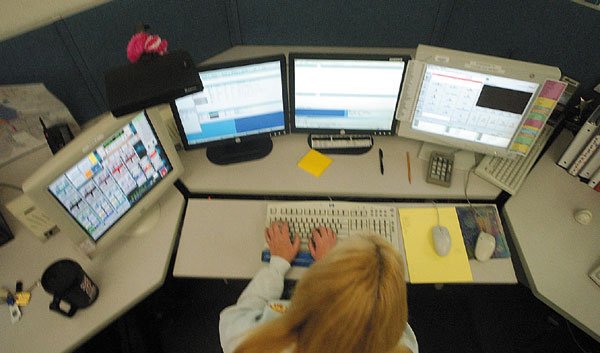Gilroy
– Patty Harrell stops mid-sentence, wheels around and takes the
call. In an instant, her day can veer from banal to nail-biting and
back.
Gilroy – Patty Harrell stops mid-sentence, wheels around and takes the call. In an instant, her day can veer from banal to nail-biting and back. One minute she’s orchestrating ambulance responses; the next, she’s fetching the number of the Phillipine embassy; five minutes later, she could be nudging a near-suicide back from the brink. She juggles calls with superhuman ease, as the radio and the emergency line pipe information into both ears. On the wall, flanked by teddy bears and family photos, there’s a subtle sign: No Whining.
Steve Ynzunza, who supervises Harrell and other Gilroy emergency dispatchers, calls it “the heart-monitor pace” of 911. Up. And down. And up. People call 911 for a laundry-list of reasons, says Ynzunza, but they don’t call to say that they’re in a good mood.
As Harrell takes the call, Cheri Carreiro, at the adjacent desk, finishes Harrell’s dropped thought: How do you handle those high-stakes calls, emotionally?
“You’ve got to let it roll off your back,” said Carreiro, her voice ragged from a winter cold. “You have to go on to that next call.”
Hanging up, Harrell slips back into the conversation, as effortlessly as if she never left.
“Sometimes I’ll ask the officers about what happened to a caller,” Harrell says. “The lack of closure – it can get to you.”
Carreiro shakes her head. “Sometimes I don’t want to know,” she says. “It complicates my life.”
And for Gilroy’s emergency dispatchers, life is complicated enough. Four monitors blink and bleat, reporting the bad news of a dozen different telephone lines. A digital clock ticks mercilessly away, neon-green seconds slipping on each desperate call. And for every problem smoothed by technology, new wrinkles arise.
Take cell phones. Since mobile phones multiplied, calls to 911 centers have, too. More calls might mean new information, but it also means new delays, as dozens call to report the same fender-bender or fire.
“We teach dispatchers to answer each call and question each caller as if they’re the first,” said Bob Smith, Director of Communications Centers and 911 Service for the Association of Public Safety Communications Officials, speaking from his Florida office. “It can be helpful – with multiple calls from an incident, each may have more information. But it’s also time-consuming, and starts to cut into response times.”
Cell phones provide scant information on where the caller is, forcing dispatchers to quiz callers on their exact location. A year ago, Gilroy’s center began getting information from the cellular towers that bounce signals to mobile phones. That signal can give dispatchers a region, said Ynzunza, but it can also prove wildly inaccurate: Calls from San Francisco sometimes bounce to Santa Clara towers. And portable numbers mean a 408 area code, once a dead ringer for San Jose or Gilroy, doesn’t clue in a dispatcher.
“Plus, now people can dial 911 from their computer,” said Ynzunza. “For us, it’s crazy!”
Dispatchers’ organizations, such as APCO, have led the legislative push to require voice-over Internet providers to transmit caller information to 911 centers. One such provider, Vonage, recently agreed to pay $220,000 to the state of Texas, to settle claims that the company didn’t adequately explain the limitations of its 911 service: calls from the computer don’t tell dispatchers a location.
For dispatchers, the stakes are high. On traffic stops, dispatchers have limited time to search warrants, missing persons’ reports and restraining orders before police must let drivers go; on emergency calls, every second spent locating a caller is a second longer before help arrives. If dispatchers slip, lives can be lost. Last October, a mis-pronounced street name and an outmoded mapping system in San Joaquin County delayed emergency response more than 20 minutes. One patient died, and two dispatchers were fired.
Under that kind of pressure, dispatchers are finally gaining respect.
“It used to be seen as a phone-answering service,” said Harrell, who’s worked 17 years as a dispatcher. “Now, it’s seen as a profession. People realize the people behind those phones and radio better know what they’re doing – lives are at stake.”
Gilroy’s dispatchers train three months in-house, minimum, and attend a three-week academy, required by the state. Every other year, they train another 24 hours, to keep up with new technologies and laws. But dispatchers say it takes at least a year and a half for the panic to subside each time the phone rings.
“TV glamorizes this job,” said Harrell. “We’ve seen trainees who’ve prepared four to six months, maybe they’ve done a sit-along, but then they have to do it … One trainee said to me, ‘This is too real.’ Well, yeah, it’s real. It’s 911.”
Stress is ever-present. Carreiro skips town for Guam and Palau; Harrell hikes and shoots hoops with her sons to decompress. Black humor helps, but Carreiro hastens to halt the jokes, when she’s not at work. Yet even outside of the station, they can’t quite escape the job. “Scanner-listeners,” as Harrell dubs them, greet them as local celebrities. In grocery lines and at the outlets, shoppers recognize their voices.
“I had no idea what I was getting into, when I took this job,” says Harrell. “But I love it. Every day is something different. You can never know enough. You can never learn enough.”















